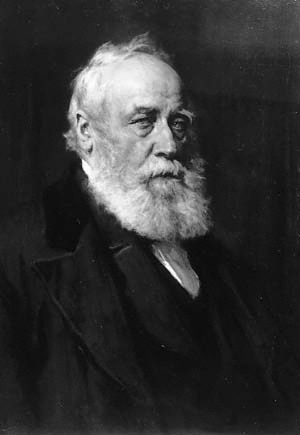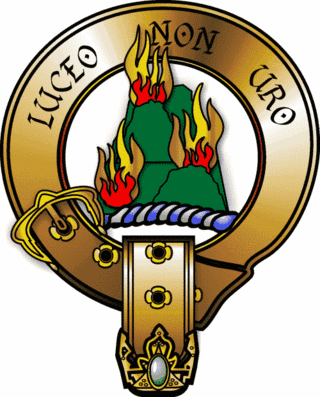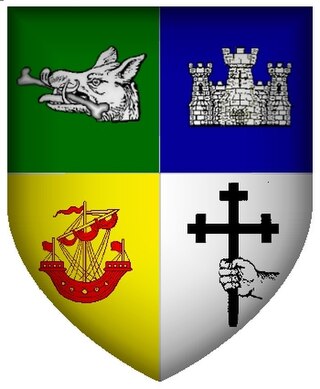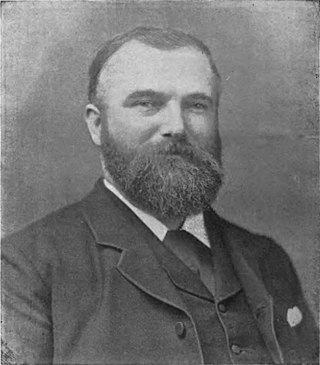
William Forbes Skene WS FRSE FSA(Scot) DCL LLD, was a Scottish lawyer, historian and antiquary.
Leod was the eponymous ancestor and founder of Clan MacLeod and Clan MacLeod of Lewis. Almost nothing is known about him and he does not appear in any contemporary records. Tradition dating to the late 18th century made him a son of Olaf the Black who was King of Man. Heraldic evidence, dating to the late 17th century, is considered to be the earliest evidence of descent from Olaf the Black. However, in recent years, this traditional lineage has been challenged and is no longer considered fact by one historian.

Clan Mackenzie is a Scottish clan, traditionally associated with Kintail and lands in Ross-shire in the Scottish Highlands. Traditional genealogies trace the ancestors of the Mackenzie chiefs to the 12th century. However, the earliest Mackenzie chief recorded by contemporary evidence is Alexander Mackenzie of Kintail who died some time after 1471. Traditionally, during the Wars of Scottish Independence, the Mackenzies supported Robert the Bruce, but feuded with the Earls of Ross in the latter part of the 14th century. During the 15th and 16th-centuries the Mackenzies feuded with the neighboring clans of Munro and MacDonald. In the 17th century the Mackenzie chief was made Earl of Seaforth in the peerage of Scotland. During the Scottish Civil War of the 17th century the Mackenzies largely supported the Royalists. During the Jacobite rising of 1715 the chief and clan of Mackenzie supported the Jacobite cause. However, during the Jacobite rising of 1745 the clan was divided with the chief, Kenneth Mackenzie, Lord Fortrose, supporting the British-Hanoverian Government and his relative, George Mackenzie, 3rd Earl of Cromartie, supporting the Jacobites.

Clan MacNeacail, sometimes known as Clan MacNicol, is a Scottish clan long associated with the Isle of Skye. Tradition states that, early in its history, the clan held the Isle of Lewis, as well as extensive territory on the north-western mainland. The earliest member of the clan on record is one 14th century John "mak Nakyl", who is recorded amongst Edward I of England's powerful West Highland supporters during the Wars of Scottish Independence. John Barbour's 1375 epic, The Brus, suggests that by 1316, the clan had switched allegiance to Robert I, and made a decisive intervention in the new theatre of Anglo-Scottish conflict in Ireland. The marriage of an heiress to the MacLeods of Lewis brought a severe loss of lands and power in the following generation, forcing the clan chiefs to relocate to the surviving estates on Skye. However, the MacNeacails retained local significant influence: serving, according to tradition, as members of the Council of the Lords of the Isles and as custodians of the cathedral church of the Western Isles at Snizort. In the 17th century, members of the clan began to Anglicise their surname from the Scottish Gaelic MacNeacail to various forms, such as Nicolson. Today the English variants of the Gaelic surname are borne by members of the clan as well as members of unrelated Scottish families, including the Lowland Clan Nicolson.
Gofraid mac Fergusa is an alleged ninth-century figure attested by the Annals of the Four Masters and various pedigrees concerning the ancestors of Clann Somhairle and Clann Domhnaill. If the pedigrees are to be believed, he was a son of Fergus mac Eirc, and a descendant of Colla Uais. Likewise, the two annal-entries that note Gofraid mac Fergusa claim that he was an Airgíallan ruler, who aided Cináed mac Ailpín in 835, and died sixteen years later as a ruler of the Isles. Gofraid mac Fergusa's place in the aforesaid pedigrees is chronologically impossible. The events associated with him by the annals are not supported by any contemporary or near contemporary source. In fact, the two annal-entries that recount these alleged events are fabricated additions inserted into the chronicle at some point before the mid seventeenth century.
The Poppleton manuscript is the name given to the fourteenth-century codex probably compiled by Robert of Poppleton, a Carmelite friar who was the Prior of Hulne, near Alnwick. The manuscript contains numerous works, such as a map of the world, and works by Orosius, Geoffrey of Monmouth and Gerald of Wales. It is now in the Bibliothèque Nationale, Paris.

Clan MacKinnon is a Highland Scottish clan from the islands of Mull and Skye, in the Inner Hebrides.

The origins of the Kingdom of Alba pertain to the origins of the Kingdom of Alba, or the Gaelic Kingdom of Scotland, either as a mythological event or a historical process, during the Early Middle Ages.
The Collectanea de Rebus Albanicis was written by members of the Iona Club of Edinburgh in the 19th century. It contains a transcription and translation of the MS 1467. The Iona Club was founded in 1833 by historian Donald Gregory and William Forbes Skene to "investigate and illustrate the History, Antiquities and early literature of the Highlands". The club is now defunct.

Clan MacLaren is a Highland Scottish clan. Traditional clan lands include the old parish of Balquhidder which includes the villages of Lochearnhead and Strathyre, and is about 18 miles (29 km) long and 7 miles (11 km) broad, spanning 54,675 acres (22,126 ha), long known as "Maclaren Country".

Clan Macfie is a Highlands Scottish Clan.
Clan Gillanders, also known in Scottish Gaelic as Clann Ghille Ainnriais, is a Scottish clan whose genealogy is preserved in the 15th-century manuscript MS 1467.

Dr Alexander MacBain M.A., LL.D. was a Scottish philologist, best known today for An Etymological Dictionary of the Gaelic Language (1896).
Torquil MacLeod was a Hebridean lord and is today considered to be the founder of the MacLeods of Lewis, who are known in Gaelic as Sìol Torcaill. He was the son of Murdoch MacLeod, and a great-grandson of Leod, eponymous ancestor of the MacLeods.
Clann Somhairle, sometimes anglicised as Clan Sorley, refers to those Scottish and Irish dynasties descending from the famous Norse-Gaelic leader Somerled, King of Mann and the Isles, son of Gillabrigte (†1164) and ancestor of Clann Domhnaill. Primarily they are the Clan Donald, formerly known as the Lord of the Isles, and the mainland Clan MacDougall, and all their numerous branches. Clan Macruari are their lost sept.
Paul Mactire, also known as Paul MacTyre, and Paul M'Tyre, was a 14th-century Scotsman who lived in the north of Scotland. He appears in several contemporary records, as well as in a 15th-century genealogy which records his supposed ancestry. He is known to have married a niece of the brother of the Earl of Ross. According to later tradition, he was a notorious robber, or freebooter in the north of Scotland; and, according to local tradition, he was the builder of a now ruinous fortress in Sutherland. He is said to be the ancestor of several Scottish families. According to some sources Paul Mactire's father was Leod Macgilleandrais.

Suibhne mac Duinnshléibhe was a late 12th-century, and early 13th-century, lord in Argyll. He does not appear in contemporary records, although his name appears in the patronymic names of two of his sons. Suibhne appears in the 16th century Leabhar Chlainne Suibhne, which documents the early history of Clann Suibhne. This account claims that he is the ancestor of Irish clan, and that he was the builder of Castle Sween in Knapdale, Argyll. However, other sources suggest the castle was built in the late 11th century by Suibhne MacAnrahan, brother of the High King of Ireland. Suibhne is said to be identical to the "Swineruo", or Suibhne Ruadh, recorded in the Ane Accompt of the Genealogie of the Campbells, a 17th-century Clan Campbell genealogy.
Kermac Macmaghan was a thirteenth-century Scottish nobleman. In 1262, he is stated to have aided William I, Earl of Ross in a particularly vicious attack in the Hebrides. The assault itself is recorded by a thirteenth-century Scandinavian saga, and was likely conducted on behalf of Alexander III, King of Scotland, who wished to incorporate Isles into the Scottish realm. The following year, Hákon Hákonarson, King of Norway launched an expedition into the Isles to reassert Norwegian authority. The latter's campaign proved to be an utter failure, and after his departure and death the same year, the Scots forced the submission of the leading magnates of the Isles. In 1264, Kermac is recorded to have received compensation for services rendered. A fifteenth-century pedigree concerning Clan Matheson seems to indicate that Kermac is identical to a certain Coinneach mac Mathghamhna, ancestor of the clan. The latter may or may not be an ancestor of Clan Mackenzie.
Clan Ewen of Otter, was a Scottish clan which once controlled the area around Kilfinan on the Cowal peninsula in Argyll.
Thomas McLauchlan (1815–1886) was a Scottish minister and theological author who served as Moderator of the General Assembly for the Free Church of Scotland 1876/77.











